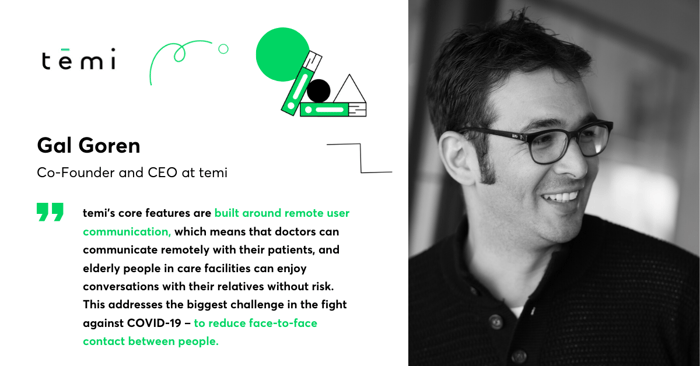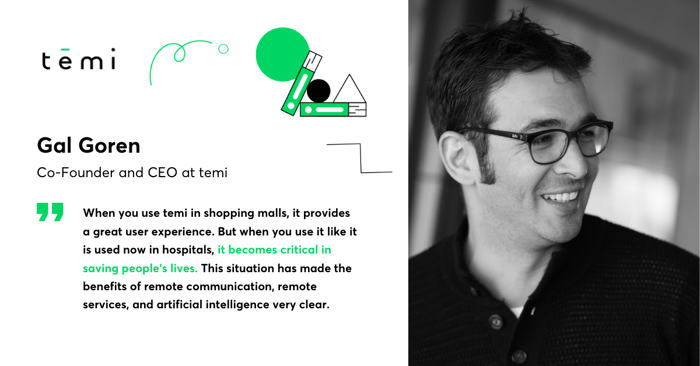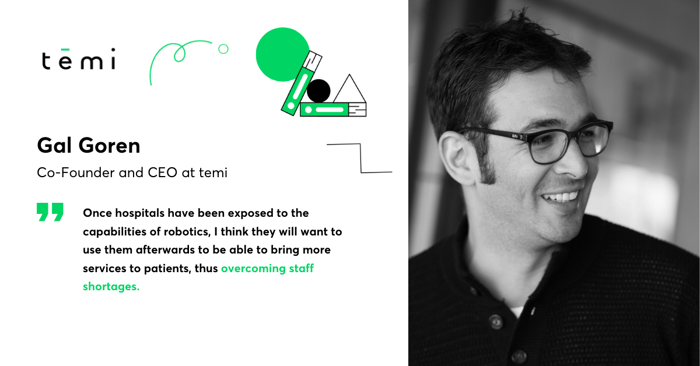How Robots Are Supporting Healthcare in the Fight Against COVID-19 – Interview With Gal Goren
.jpg?width=1000&height=525&name=Gal%20Goren%20interview%20(1).jpg)
Minimizing contact between patients and frontline staff is critical, but it’s also a significant challenge for healthcare providers to achieve.
At the same time, patients affected by COVID-19, and those in elderly care facilities have been cut off from their families and friends to prevent the spread of the virus. But while there has been no shortage of bad news, there have also been some glimmers of hope amongst the gloom. Robots are offering both healthcare providers and patients a remarkable solution to an unprecedented set of difficulties.
temi, for example, is an intelligent, mobile personal robot that lets you take video calls on the move, among its many other uses.
I caught up with Gal Goren, CEO at temi, to find out what robotics, and specifically temi, has been doing to ease the current challenges in healthcare.
Kasia Wolska, Netguru: We’ve heard a lot recently about the struggles faced by medical professionals in treating COVID-19 patients. How can temi support healthcare in the fight against the disease?
Gal Goren, CEO at temi: temi’s core features are built around remote user communication, which means that doctors can communicate remotely with their patients to ask, for example, how they are, and elderly people in care facilities can enjoy conversations with their relatives without risk. This addresses the biggest challenge in the fight against COVID-19 – to reduce face-to-face contact between people.

temi can also navigate from point A to B without the need to be controlled, so in terms of healthcare support, temi can independently bring the services patients need to any point in a hospital. It can be integrated with many devices: hospitals can integrate equipment on temi like thermometers and blood pressure monitors and check patients’ vital signs remotely.
That sounds great. You mentioned video calls, patient checks, and measuring temperatures. Do you have any other real-life stories of how temi has been deployed in healthcare?
Some of our customers have integrated a disinfectant machine that goes between rooms. Others installed handwashing devices so that temi can take them to specific areas.
And we know of a few other cases where temi is used to carry specific equipment to where it’s needed in the hospital. All of these solutions achieve one specific goal – to minimize contact between individuals.
Because of the numerous benefits temi brings to healthcare, the ministry of health and the ministry of defence in Israel chose temi as the leading solution to equip all hospitals in Israel.
So you say that temi can help with remotely checking patients, but are there limitations? What are the areas that temi can’t assist with?
We are not replacing any activity that should be done by doctors. But there are very many simple activities that require a doctor’s presence – to ask questions, provide supplies like food or medicine – and that is where temi makes a huge difference. We’re able to reduce face-to-face contact in situations that don't need any specific or complicated medical intervention.
It sounds like temi is ideal for healthcare. What was the idea behind it?
It’s really important to remember that temi wasn’t designed to fight COVID-19. We originally designed temi for B2B, such as when you enter a retail store, and the robot understands you need assistance. temi has a face recognition module and can say, “Hello Kasia, how can I help you today?” If you are looking for a particular product, temi can take you there, navigate you through the store space, and then proceed to the payment with you.
So we can replace the need for human interaction with a very human-like user experience. You can use temi in restaurants, hotels, retail stores, shopping malls, government facilities, manufacturing facilities – the possibilities are endless.
It’s exciting to imagine what it could do. How did you develop temi to create so many possibilities?
We designed temi as an open platform, which means that any developer can design their own solution for temi very quickly and easily. For example, an Android app could be integrated with temi to provide a specific service.
Take the case of healthcare – the needs of different hospitals can vary greatly, for example, in the need to communicate with different databases, have different procedures, etc.). But temi can be customized to it very easily.
Are there any specific features that you had to introduce in temi for medical use?
As I mentioned, we developed a general platform that makes development and integration easy for anyone and any industry. Now we’re focusing on helping with developing solutions for our customers and focusing on healthcare solutions development. The core features of temi are related to remote user communication and autonomous navigation – be it in retail or in hospitals.
In terms of medical use, our approach has been twofold: helping hospitals to integrate hardware with temi, and dedicating R&D resources to tailor-make specific solutions for customers – as they have different needs – and to deploy them quickly.
Before COVID-19, did you imagine that temi would be used as it has been to fight an epidemic?
Actually, no... The world is a dynamic place. Certainly, no one expected that there would be a pandemic. But it’s important to adapt products and services to the new situation and support the medical staff in hospitals as much as we can.
That’s very true. So, with all the disruption in the market, do you see any changes in demand from various industries?
There is definitely a change in the demand from hospitals and elderly care facilities – and it is not only for temi but also the robotics industry as a whole.
The current situation has suddenly made it clear why remote interactions with autonomous navigation are needed. When you use temi in shopping malls, it provides a great user experience. But when you use it like it is used now in hospitals, it becomes critical in saving people’s lives. This situation has made the benefits of remote communication, remote services, and artificial intelligence very clear.

The COVID-19 situation has put a lot of focus on robotics. Before the pandemic, if you used a robot, you were considered very innovative. But I think the COVID-19 pandemic will be the time that popularized the robotics industry.
So, observing the current changes, how do you see the future of the healthcare industry?
Once hospitals have been exposed to the capabilities of robotics, I think they will want to use them afterwards to be able to bring more services to patients, thus overcoming staff shortages.

For example, we have seen cases where there are two nurses in the hospital to cover an entire department through the night. It is important to say that nurses are doing very complex and important work and the robot can not and will not replace them but, if they had a robot assistant, it would reduce the load on them dramatically.
The robot can go to patients and make sure that everything is OK. It is able to see and understand whether the patient is waking up or needs help: temi can ask if the patient remembered to take their pills and dispense the pills.
Doctors will be able to do their morning and night routines between the patients. They can visit many patients around the world while sitting in their own office. Automating activities like this will significantly reduce the load on the medical staff. So, yes, I believe that hospitals will want to use these kinds of solutions after this situation is over.
How has the COVID-19 pandemic changed the plans you had for 2020? And how does that translate into the development of new features?
We predict that doing business with retail stores and hotels will be harder in the coming months because of the travel ban and the downturn in the economy, so we’ve focused on solutions for the medical sector, which are in high demand.
We haven’t changed any core features, but we are focusing our R&D efforts to develop features customized to specific customers.
Do you feel that there are still some features to develop and some challenges to be solved?
Yes, definitely. We are keeping up with technology and we are constantly upgrading our capabilities, so in the future, there will be more markets open to us.
It depends on the use, of course, but once the technology improves and better sensors are available, it will mean that you will be able to be in areas that you cannot be in now. There is definitely a lot more that can be done.







